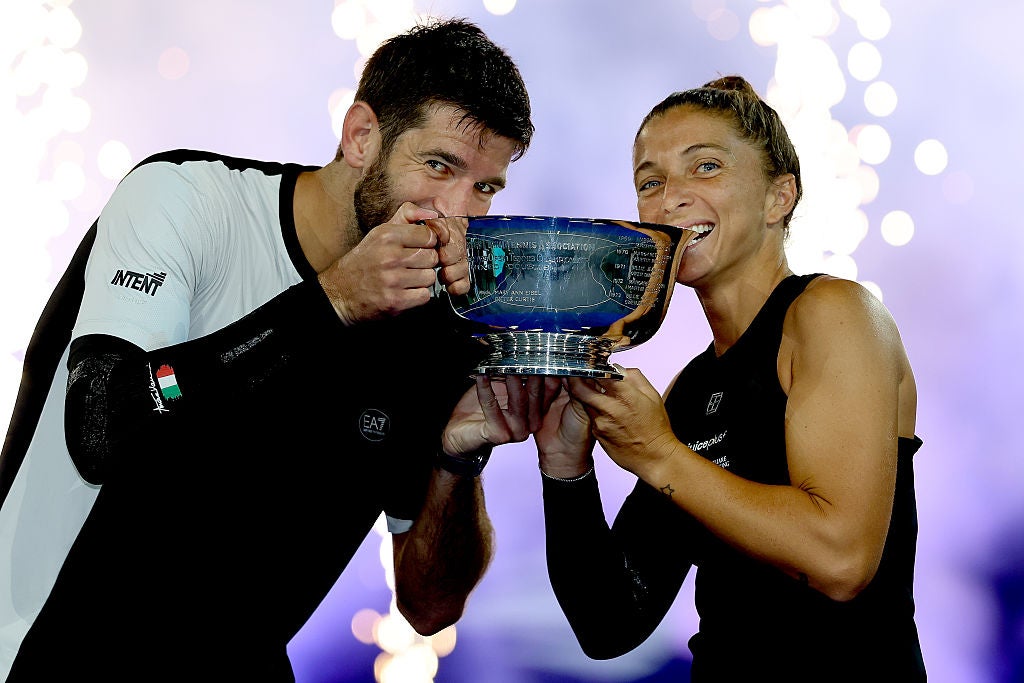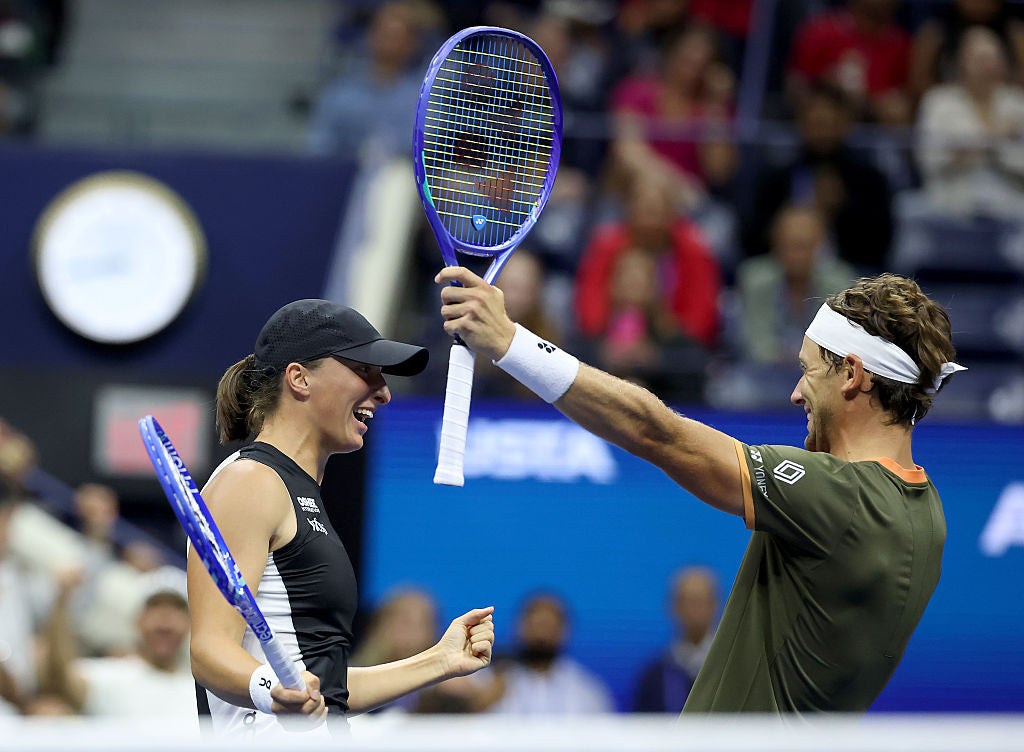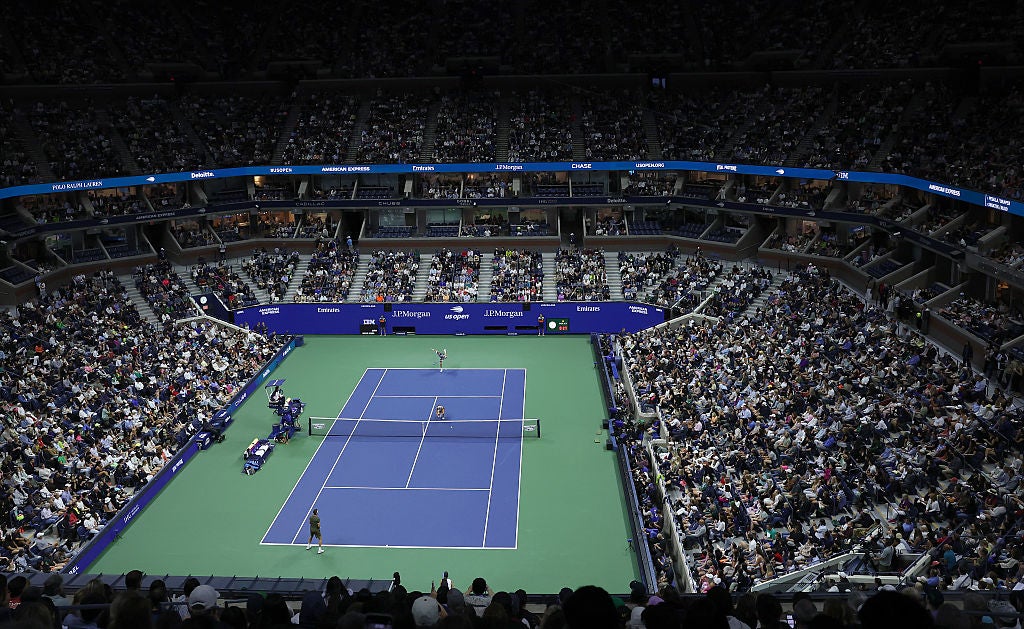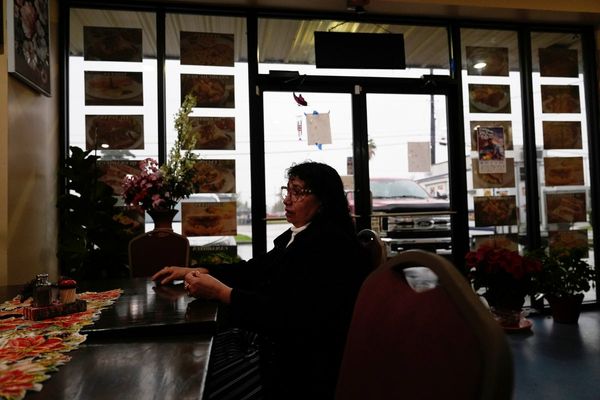
“Spectacular awaits” was the tagline adorning every advertising hoarding inside Arthur Ashe and Louis Armstrong for this week’s revamped US Open mixed doubles tournament. The final verdict may be slightly more lukewarm.
Wednesday night’s result was victory for the defending champions and only actual mixed doubles team, Sara Errani and Andrea Vavassori. It was also a win both for doubles specialists, who face an uphill battle even to be taken seriously, and for tennis purists everywhere.
And something of an embarrassment for the US Open, which made a big song and dance of the $1m (£740,000) prize pot in order to attract singles stars, only to see none of its top players take home the cheque in the end. Not that the tournament would admit that this experiment didn’t quite go to plan, of course.
In other ways the event was a roaring success: cheap tickets, headline names, and the novelty factor attracted healthy crowds, with Arthur Ashe packed for the final, and the scheduling meant all eyes were on the event rather than any clashing singles encounters – an important boon for the sport.
The tennis itself on show – while often not the highest quality – proved just how exciting mixed doubles can be, even when played by a host of teams hastily scrambled together. Vavassori said after his triumph: “These two days will be really important for doubles in the future. We showed that doubles players are great players and this product can grow.”

But the fast-four, no-ad, final set tiebreak format, the tiny draw, and the fact that the entire first round and quarter-finals were condensed into one day, inevitably cheapened the product. This had the feel of a contrived show, an eye-catching gimmick; it never once felt like a real grand slam. Even participating players Jack Draper and Karolina Muchova called it an “exhibition”, a telling slip of the tongue.
Sure, the semis and finals had a more serious feel than the knockabout on day one. But it’d be hard to argue that any of the singles stars were playing for the prestige and honour of a grand slam title, rather than the money.
Which makes a fun-and-games exho feel quite sad. The US Open may regard itself as the most forward-thinking of the slams, but there’s a fine line between innovation and completely reinventing the wheel. The majors are supposed to be the pinnacle of the sport, a test of human endurance, tactical skill and mental resilience. It’d be hard to call this event that.

Whether the executives think it’s an experiment worth repeating, as seems likely, we’ll have to wait and see. But if they do push on with their “reimagined” slam, it shouldn’t be without further changes.
The tournament was beset with problems from the beginning, with players including major draws Aryna Sabalenka and Coco Gauff pulling out, nullifying the hype as star names swapped in and out.
While the idea of watching the world’s best singles stars playing together is hugely entertaining, the pairings were meaningless. Caty McNally admitted after her first round win: “Sunday night I was home in Cincinnati and my agent called me, and he said you have 60 seconds to tell me if you want to play with Lorenzo Musetti.”
The last-minute combinations – not helped by the prolonged 1000 events in Canada and Cincinnati – meant that the majority of teams in action at Flushing Meadows did not even practise before taking to the court, justifying the criticism of many established doubles players that this was never a serious event. Naomi Osaka even turned up for her first-round match in a practice kit.

The obvious exception to that lack of effort was Errani and Vavassori. Wholly expectedly, they had a point to prove, and dumped out second seeds Elena Rybakina and Taylor Fritz (amazingly, the only actual mixed doubles pairing wasn’t seeded) in 40 minutes. The idea that a grand slam doubles match can take 40 minutes makes a mockery of the entire thing. “We were playing for the doubles teams who could not be here,” Vavassori said afterwards. “We were the team that could lose everything,” he added after the final.
And unsurprisingly, they produced the best tennis of the week. Of all the matches, Draper/Jessica Pegula vs Carlos Alcaraz/Emma Raducanu had the biggest star quality, and it was an entertaining showing.
But it was notable how much the tennis quality dropped off from the Andrey Rublev/Muchova vs Errani/Vavassori match. Not coincidentally, that encounter starred the only pairing of real doubles players, plus a team whose skill sets suit the doubles format exceptionally well. As beaten finalist Iga Swiatek said: “You proved that mixed doubles players are smarter tactically than singles players, I guess.”
Then there’s the fact that the tournament was scuppered before it even began by the never-ending disasterclass that is tennis scheduling, with Cincinnati champions Swiatek and Alcaraz given 24 hours to recover before starting play in New York on Tuesday. The ailing Jannik Sinner’s withdrawal meant that his partner Katerina Siniakova, a grand slam and Olympic mixed doubles champion, was forced out of the event. Siniakova then suffered the financial double whammy of not receiving any of the prize pot in New York, as well as not being able to play in this week’s WTA event in Cleveland.

Her share of the loot at the US Open would instead go to Danielle Collins, a former top-10 singles player who has raised eyebrows by repeatedly bragging about the expensive holidays her winnings pay for. Collins can do what she likes with her money, of course, but it feels profoundly unjust that doubles players, who scrape a living doing an equally demanding and worthwhile sport, have been deprived of a significant injection of cash.
For all that players bang on about increasing their share of tournament revenue, the usual suspects were silent on that subject this week. The US Open is a business and sees this as a commercial enterprise, but it is sport first and foremost, and players’ livelihoods are at stake.
Perhaps the way forward is to have both events co-exist: this as a fun exhibition, designed to attract more eyeballs onto a lesser-known discipline, with a real mixed doubles event – under usual grand slam rules, with a bigger draw based on doubles rankings – in its usual second-week spot.
That way everyone wins: the singles players get their paycheck, spectators get entertaining combinations and more tennis, and the doubles specialists get to do their job, playing for the prestige of a major title, with no asterisk attached.
Jack Draper’s mixed US Open run ends in defeat as doubles specialists claim $1m prize
US Open mixed doubles champions make firm statement: ‘We’re playing for them’
Why Jack Draper stunningly left Nike for new brand before US Open
When is the US Open draw? Confirmed seeds, wildcards, withdrawn players and more
Jack Draper’s mixed US Open run ends in defeat as doubles specialists claim $1m prize
US Open mixed doubles champions make firm statement: ‘We’re playing for them’







